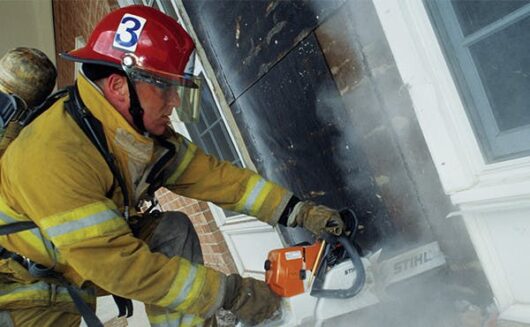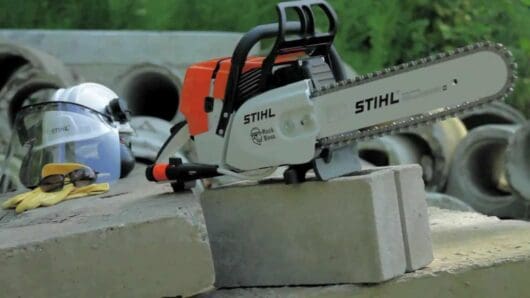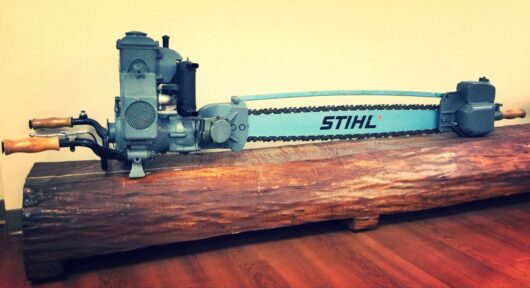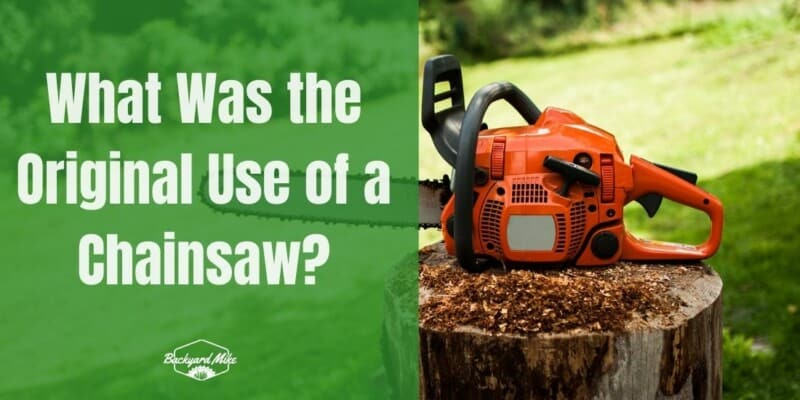Have you ever wondered what the original use of a chainsaw was? This article will explore the history of this invaluable tool, from its inception to its modern-day use. Chainsaws are an essential tool in our lives today, but what was its original purpose? Read on to find out more about the fascinating history of the chainsaw. You won’t want to miss it!
Early chainsaw development: Pre-industrial chainsaw history
A chainsaw is a powerful tool for cutting through wood and other materials. Today, it has become an indispensable part of the forestry and wood-cutting industry. However, the chainsaw’s history dates back decades and its early development was closely tied to the needs of pre-industrial societies.
One of the first known uses of a chainsaw-like tool dates back to the late 18th century, when two Scottish doctors, James Jeffray and John Aitken, started to experiment with various cutting devices. Aitken and Jeffray’s design consisted of a large-toothed chainsaw blade that was operated by two people, with each one pulling on one end of the chain. This device was designed for cutting through bone during surgical procedures, but it also started to be used for cutting timber.
Despite the early success, the chainsaw did not actually become a widely used tool until the 19th century. Eventually, the rise of the logging industry helped create a need for more efficient methods of cutting timber. The early chainsaws were typically operated by two operators, with one person holding the saw and the other one pulling on a cord to turn the chain. These early chainsaws were quite heavy and unwieldy, but they were still more efficient than hand saws.
Early chainsaw development: The first modern chainsaw
The modern chainsaw, as they are known today, has a rich history that dates back more than a century. The invention of the modern chainsaw revolutionized the logging industry and made cutting timber much more efficient and safer. The first modern chainsaw, also known as the “Endless Chain Saw” was invented by Andreas Stihl, a German mechanical engineer in 1927.
Stihl was born in Zurich, Switzerland in 1896 and grew up in Germany. He would work as an apprentice in his father’s small mechanical engineering shop and studied engineering at the Swiss Federal Institute of Technology in Zurich later. After he completed his studies, he returned to his family’s business and started to experiment with a variety of mechanical devices.
In the early 1920s, he turned his attention to the growing problems with cutting timber. At the time, the loggers used crosscut saws for felling trees. Not only were these chainsaws extremely slow, but they also needed a great deal of physical effort. Stihl started working on a new type of chainsaw that would be less labor-intensive and much more efficient.
The first chainsaws that were developed by Stihl were cumbersome, two-person machines that needed one person for holding the chainsaw and another for pulling on a rope to turn the chain. Despite the inefficiency, these early chainsaws were a major improvement over traditional chainsaws. They quickly gained popularity among loggers.
In the years that followed, the chainsaw underwent a series of innovations to make it more effective. In 1927, Stihl patented his first modern, gasoline-powered chainsaw. It was much lighter and easier to operate compared to the earlier models. The design unveiled by Stihl featured a single-operated design with a small, two-stroke engine and a chain that was lubricated by oil pumped from a reservoir. This design ended up being a major breakthrough in the development of the chainsaw, and it became the industry standard.
By the 1930s, Stihl’s chainsaw had become incredibly popular. To improve the chainsaw, he continued to innovate and improve his designs. In 1937, he officially unveiled the first electric chainsaw. This chainsaw was cleaner and quieter than the gas-powered models. Stihl also developed a wide range of chainsaw accessories like guide bars, chains, and more than improved the tool’s efficiency and versatility.
Ultimately, Stihl became one of the leading manufacturers and other power tools all over the world. These chainsaws were widely used by loggers, landscapers, and homeowners around the world. The innovations of these chainsaws have played a major role in the development of modern forestry and landscaping practices.
Chainsaw uses in the industrial age: Early use in logging and agriculture

The chainsaw has long been an important tool in both the logging and agricultural industries for almost a century. The invention of the chainsaw revolutionized the way trees and crops were crafted. It allowed for more efficient and safer methods of cutting. The early use of chainsaws in the logging and agriculture industries helped transform the way people work with natural resources.
The logging industry was one of the earliest adopters of the modern chainsaw. Before the chainsaw’s invention, loggers would use crosscut saws for felling trees. This was a slow process and needed a great deal of physical effort. In the early 20th century, mechanical chainsaws started to emerge as a more efficient alternative. These early chainsaws used to be operated by two people. One of them had to hold the saw while the other had to pull on a cord to turn the chain.
In 1927, German engineer Andreas Stihl came out with the first modern chainsaw. It was a lighter design that was much easier to operate. It quickly became the industry standard, and its adoption helped make logging faster and safer. Today, chainsaws are used all over the world for felling trees, trimming branches, and cutting logs into lumber.
The chainsaws used in the logging industry are typically larger and much more powerful compared to the ones used in other industries. They feature longer bars and more powerful engines, which allow them to cut through large trees quickly and easily. However, the use of chainsaws in logging has led to environmental concerns, including deforestation and habitat loss.
The use of chainsaws in agriculture started in the mid-20th century. Before the introduction of chainsaws, the farmers would use hand tools like scythes and sickles for harvesting crops. These tools were rather time-consuming and needed a great deal of physical effort, which made the harvesting process extremely slow and inefficient.
The introduction of chainsaws changed everything. Farmers quickly adopted chainsaws for harvesting crops like corn, hay, and sugar cane. The chainsaw’s efficiency allowed the farmers to harvest their crops much faster and with less physical strain. Today, chainsaws are still widely used in agriculture, but they have been replaced to an extent by more specialized tools like mowers and crop harvesters.
The chainsaws used in agriculture are typically smaller and much lighter compared to the ones used in logging. They’re designed to be easy to maneuver and can be used for cutting through thick vegetation or clearing away debris.
In both logging and agriculture industries, the use of chainsaws needs careful training and attention to safety. Chainsaws can be extremely dangerous if not used properly, and the workers need to be properly trained in their use. Further, you must be wearing appropriate safety gear, including a helmet, face shield, ear protection, eye protection, gloves, steel-toed boots, and more.
Chainsaw uses in the industrial age: Use in mining and construction
While chainsaws are commonly associated with logging and other wood-cutting tasks, the industrial age also saw chainsaws being used in a wide range of applications in the mining and construction industries. Chainsaws are capable of cutting through hard materials like rock, concrete, and more. Further, it can be used for clearing away debris and obstacles. The use of chainsaws in these industries has greatly helped make work faster, more precise, and more efficient.
In the mining industry, chainsaws are used for a wide variety of tasks, including cutting through hard rock, removing obstacles, and clearing tunnels. In underground mining, where space is generally limited, chainsaws can be particularly useful for cutting through rock and debris in hard-to-reach areas. In surface mining, chainsaws can be used for cutting through thick vegetation or for removing trees and stumps before starting the excavation work.
In the construction industry, chainsaws are commonly used for cutting through concrete and other hard materials. For instance, chainsaws can be used for making precise cuts in concrete walls or floors for creating openings for doors, windows, or utilities. They can even be used for cutting through concrete or asphalt pavement for removing obstacles like fallen trees, or for clearing away debris from demolition work.
Chainsaws used in these industries are specialized tools designed for heavy-duty work. They might feature longer bars and more powerful engines compared to the ones used in logging or agriculture. They also come with specialized chains that are appropriate for cutting through hard materials. Some chainsaws used in mining or construction might also be pneumatic or hydraulic, while they’re powered by compressed air or fluid instead of gas or electricity.
Here are the different types of materials you can cut with a chainsaw during construction –
#1. Stones
Cutting stones with the traditional chainsaw may be alarming, as it will reduce the lifespan and make the chainsaw dull. However, there are special types of chainsaws that are compact and high-powered. These chainsaws are capable of chopping bricks and concrete drywalls easily.
#2. Metal
Although you are not restricted to only using chainsaws for cutting metal, it is possible. However, using a standard chainsaw may cause trouble. Instead, you should be using specialized chainsaws with hard metal cutting edges for cutting through tough metals. Remember not to use a regular chainsaw for cutting metals.
#3. Plastics
Chainsaws are capable of cutting plastics, including Plexiglas, Polyethylene, Acrylic, Polypropylene, Lexan, and Polycarbonate.
#4. Glass
You can easily cut glass using circular or special glass-cutting chainsaws. Otherwise, using other types of tools could result in difficult situations.
Chainsaw uses today
Chainsaws are highly versatile tools that are regularly used in a wide variety of tasks, from felling trees in the forest to using chainsaws for home use, firefighting, agriculture, and more. Here are the different industries in which chainsaws are used today –

#1. Logging
Logging is one of the primary industries that rely heavily on chainsaws. In the modern era, loggers make use of chainsaws for cutting down trees and trimming them into logs for transportation to sawmills. Chainsaws used in the logging industry are generally larger and more powerful compared to those used for home improvement tasks, as they are designed for cutting through thick trunks quickly and efficiently. Chainsaws in the logging industry often come with longer bars and more powerful engines for making work faster and more productive.
#2. Agriculture
In agriculture, chainsaws are used for a wide variety of tasks, such as pruning trees, cutting logs, clearing land, and harvesting crops. Farmers and farmworkers often use chainsaws to manage vegetation and maintain their farms. Chainsaws used in agriculture tend to be smaller and lighter compared to the ones used in the logging industry. However, they still need proper training and safety measures.
When using chainsaws for agriculture, farmers and farmworkers need to take into consideration the type of vegetation they’re cutting and any potential hazards such as stumps or rocks. Proper safety gear such as gloves, steel-toed boots, eye protection, noise protection, etc. should be worn at all times to prevent accidents and injuries. Chainsaws in agriculture are used for pruning and shaping fruit trees, which need precision and skill.
#3. Mining and construction
In mining, chainsaws are generally used for cutting through rock or other hard materials. The blades on these chainsaws are designed specially to be able to cut through rock or other hard surfaces quickly and efficiently. Using chainsaws in mining is particularly important in the early stages of mine development, when rocks and other materials have to be cleared away for accessing the ore deposits.
Remember that using chainsaws in mining can be relatively dangerous, so proper training must be undertaken. Moreover, you must take proper safety measures. The operator must be skilled in their use of chainsaws and wear appropriate safety gear. Further, chainsaws used for mining need to be maintained regularly for ensuring they are in good working order.
In construction, chainsaws are used for a wide variety of tasks, such as cutting concrete, wood, and metal. Construction workers make use of chainsaws for making cuts in materials that are too difficult or too thick to cut using other tools. The chainsaws used for construction are typically heavy-duty, high-powered machines that are designed for making precise cuts and withstand the rigors of construction work.
#4. Home improvement tasks
Chainsaws are also commonly used for home improvement tasks like cutting firewood, trimming trees, clearing bushes, and more. Homeowners make use of chainsaws for cutting down small trees and branches, as well as for pruning overgrown trees and bushes. Further, chainsaws are also used for cutting lumber for construction projects. Chainsaws used for home improvement tend to be typically smaller and less powerful compared to the ones used in the logging industry. Homeowners can make use of battery-powered or electric chainsaws, which are quieter and produce fewer emissions compared to gas-powered models.
Lately, advances in technology have led to the development of new chainsaw models that are more efficient and safer to use. These models might include features like automatic oiling, anti-vibration technology, and self-sharpening chains for reducing operator fatigue and increasing comfort. Many chainsaws also come with safety features like chain brakes that stop the chain from spinning during accidental kickback.
#5. Environmental management
For environmental management, chainsaws are often used for the restoration and maintenance of forests, wetlands, and other natural habitats. Chainsaws are used for a wide range of tasks, including tree felling, thinning, pruning, and selective cutting. By selectively removing trees and other vegetation, chainsaws will help you in reducing the risk of wildlife, promote forest health, and increase biodiversity.
In wetlands, chainsaws are used for clearing invasive species like phragmites, which can take over and choke out native vegetation. Chainsaws are also used for removing dead trees and bushes, which can help improve water flow and reduce flooding risks.
The chainsaws used in environmental management should only be operated by skilled professionals who are trained in the use of chainsaws and have a thorough understanding of ecological systems.

#6. Wildlife management
Chainsaws are also used in wildlife management for a wide range of tasks such as clearing paths, creating firebreaks, or opening up dense vegetation for providing feeding and breeding habitats for wildlife. Chainsaws are also used for removing dead and hazardous trees, which reduces the risk of injuries and damage to wildlife habitats.
When working with wildlife, chainsaw operators should take care that they do not disturb the animals or their habitats. Workers should also follow the necessary safety guidelines and be aware of potential hazards like uneven terrain, hidden obstacles, and fallen trees.
The chainsaws used in wildlife management should be lightweight and maneuverable, which will allow the operator to work in tight spaces and difficult terrain. Features like automatic oiling and vibration-reducing technology will also reduce operator fatigue and increase safety.
#7. Firefighting
Chainsaws are also used in firefighting for a wide variety of tasks like creating firebreaks, clearing debris, and cutting through fallen trees and other obstacles. They are also used for cutting ventilation holes in roofs and walls to allow smoke and heat to escape during a fire.
The chainsaws used for firefighting need to be powerful, durable, and lightweight, which allows firefighters to operate them safely and efficiently in difficult and dangerous conditions. They should also be equipped with safety features like anti-vibration technology, emergency stop switches, and more.
When you are using chainsaws in firefighting, safety will be paramount. The firefighters should be properly trained in the use of chainsaws and wear appropriate safety gear, including fire-resistant clothing. Further, they should also be aware of potential hazards like fallen power lines and unstable structures.
#8. Tree surgery
Chainsaws are used for a variety of tasks in tree surgery such as pruning, shaping, and removing trees. They are also used for removing dead or hazardous branches and limbs. Further, you can even use it to reduce the risk of injury or damage to property.
Chainsaws used in tree surgery should be precise and efficient, which allows tree surgeons to work quickly and safely. They should be lightweight and maneuverable, allowing them to work in tight spaces and difficult terrain.
Check out the detailed guide on the best professional chainsaws, which will help you make an informed decision about which one suits you best
When using chainsaws for tree surgery, safety will be critical. A tree surgeon should be trained properly and experienced with using chainsaws. Moreover, appropriate safety gear must be worn. Tree surgeons should be aware of potential hazards like falling limbs, unstable trees, and hidden obstacles.
FAQs
What is the original use of a chainsaw?
The original use of a chainsaw was to cut down trees, which was a difficult and dangerous task before the invention of the chainsaw. Chainsaws are powerful and effective tools that can quickly and safely cut through large logs and trees.
Why did they invent chainsaws?
Chainsaws were invented to make the process of cutting down trees and logs easier and safer. Prior to the invention of the chainsaw, the process of cutting down trees was slow and laborious, and often dangerous. Chainsaws enabled people to quickly and safely cut down trees and logs with greater efficiency.
What is the difference between a chainsaw and other cutting tools?
Chainsaws are equipped with a powerful rotating chain blade that is designed to quickly and effectively cut through large logs and trees. Other cutting tools, such as saws and axes, are designed for cutting softer materials and are not as powerful or effective as chainsaws


